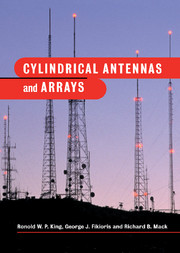Book contents
- Frontmatter
- Contents
- Preface
- Preface to first edition
- 1 Introduction
- 2 An approximate analysis of the cylindrical antenna
- 3 The two-element array
- 4 The circular array
- 5 The circuit and radiating properties of curtain arrays
- 6 Arrays with unequal elements: parasitic and log-periodic antennas
- 7 Planar and three-dimensional arrays
- 8 Vertical dipoles on and over the earth or sea
- 9 Dipoles parallel to the plane boundaries of layered regions; horizontal dipole over, on, and in the earth or sea
- 10 Application of the two-term theory to general arrays of parallel non-staggered elements
- 11 Resonances in large circular arrays of perfectly conducting dipoles
- 12 Resonances in large circular arrays of highly conducting dipoles
- 13 Direct numerical methods: a detailed discussion
- 14 Techniques and theory of measurements
- Appendix I Tables of Ψd R, T(m) or T′(m) and self-and mutual admittances for single elements and circular arrays
- Appendix II Tables of matrix elements Φu and Φυ for curtain arrays
- Appendix III Tables of admittance and impedance for curtain arrays
- References
- List of symbols
- Index
6 - Arrays with unequal elements: parasitic and log-periodic antennas
Published online by Cambridge University Press: 07 August 2009
- Frontmatter
- Contents
- Preface
- Preface to first edition
- 1 Introduction
- 2 An approximate analysis of the cylindrical antenna
- 3 The two-element array
- 4 The circular array
- 5 The circuit and radiating properties of curtain arrays
- 6 Arrays with unequal elements: parasitic and log-periodic antennas
- 7 Planar and three-dimensional arrays
- 8 Vertical dipoles on and over the earth or sea
- 9 Dipoles parallel to the plane boundaries of layered regions; horizontal dipole over, on, and in the earth or sea
- 10 Application of the two-term theory to general arrays of parallel non-staggered elements
- 11 Resonances in large circular arrays of perfectly conducting dipoles
- 12 Resonances in large circular arrays of highly conducting dipoles
- 13 Direct numerical methods: a detailed discussion
- 14 Techniques and theory of measurements
- Appendix I Tables of Ψd R, T(m) or T′(m) and self-and mutual admittances for single elements and circular arrays
- Appendix II Tables of matrix elements Φu and Φυ for curtain arrays
- Appendix III Tables of admittance and impedance for curtain arrays
- References
- List of symbols
- Index
Summary
The general theory of curtain arrays which is developed in the preceding chapter requires all N elements to be identical geometrically, but allows them to be driven by arbitrary voltages or loaded by arbitrary reactors at their centers. If some of these voltages are zero, the corresponding elements are parasitic and their currents are maintained entirely by mutual interaction. In arrays of the well-known Yagi–Uda type, only one element is driven, so that the importance of an accurate analytical treatment of the inter-element coupling is increased. In a long array the possible cumulative effect of a small error in the interaction between the currents in adjacent elements must not be overlooked. As an added complication, the tuning of the individual parasitic elements is accomplished by adjustments in their lengths and spacings. This introduces the important problem of arrays with elements that are different in length and that are separated by different distances. In the Yagi–Uda array the range of these differences is relatively small. On the other hand, in frequency-independent arrays of the log-periodic type the range of lengths and distances between adjacent elements is very great.
In this chapter the analytical treatment of arrays with elements that are different in length and unequally spaced is carried out successively for parasitic arrays of the conventional Yagi–Uda type and for driven log-periodic arrays. However, the formulation is sufficiently general to permit its extension to arrays of other types, both parasitic and driven, that involve geometrically different elements.
- Type
- Chapter
- Information
- Cylindrical Antennas and Arrays , pp. 153 - 240Publisher: Cambridge University PressPrint publication year: 2002

